Guardian.com: Electric ‘Boris cars’ are coming to London – how do they work in Paris?
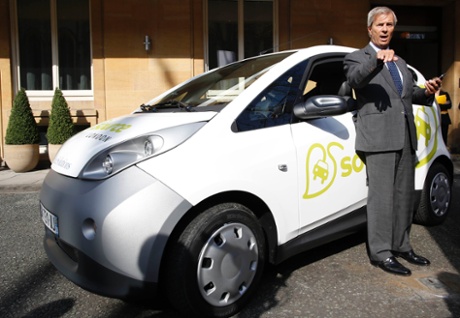
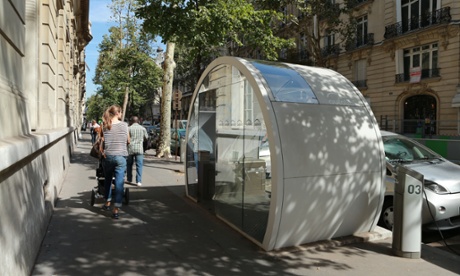
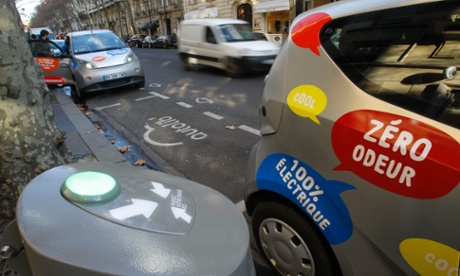
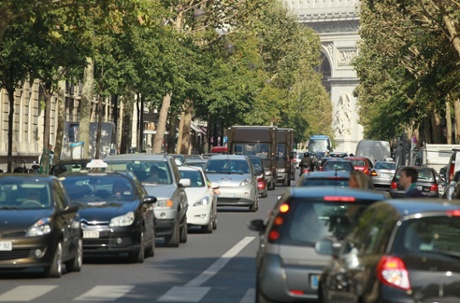
When the electric car-sharing scheme Autolib’ launched in the French capital, staff were advised to expect a complete disaster. Three years and 30m miles later, the biggest concern is pigeons
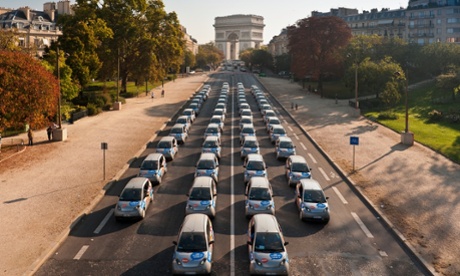

Autolib’ electric cars in front of the Arc de Triomphe in Paris.
Jean-Philippe Wailliez, who runs a small wine business in Paris, finds he uses one “actually pretty regularly. Three, four times a week, maybe, instead of the metro or the commuter train. It really is a very useful service. Especially when I have to make deliveries.”
Emanuelle Buet is on her way to an urgent, unscheduled meeting on the other side of town, further from a metro station than any self-respecting Parisian would ever want to walk. “I have a car, but it’s in the multi-storey 10 minutes away,” she says. “It’ll take forever to get out, and twice as long again to find somewhere to park at the other end.”
Sarah Maurel and her colleague have just used one for the first time. “Brilliant,” she says. “We had a client briefing in Champigny-sur-Marne, and a train strike. Thirty minutes there, 40 back, way cheaper than a taxi. It took time to get used to – the brakes are a bit sensitive. But very happy.”
By any measure – including, judging from a random sample quizzed on the pavement last month, customer satisfaction – Paris’s Autolib’ electric car sharing scheme is looking like a success. Membership is up from 5,650 a month two-and-a-half years ago to 155,000 today. Between them, those members have clocked up the fairly remarkable total of 30.4 million miles. The service’s 2,500 Bluecars – hitting 3,000 by the end of this year – are now averaging a total of well over 10,000 rentals every day.
“We’re pleased,” says Véronique Haché-Aguilar, managing director ofAutolib’ Métropole, which groups the 63 town councils in and around Paris that operate the scheme. “The main aim was to cut air pollution and reduce the load conventional cars place on the city, but still give people an easy option to use a car when they really need one. I think we’re making progress.”
Launched as a complement to Velib’, the municipal cycle-sharing scheme set up in Paris in 2007 by former Socialist mayor Bertrand Delanoe, Autolib’ was first mooted in 2009, opened for service – with 250 cars – in December 2011, and has since expanded to Lyon (as Bluely) and Bordeaux (Bluecub) in France, and Indianapolis in the United States. As Source London, a commercial proposition of which Transport for London is “supportive”, it will be arriving in the British capital next year.
Jean-Philippe Wailliez, who runs a small wine business in Paris, finds he uses one “actually pretty regularly. Three, four times a week, maybe, instead of the metro or the commuter train. It really is a very useful service. Especially when I have to make deliveries.”
Emanuelle Buet is on her way to an urgent, unscheduled meeting on the other side of town, further from a metro station than any self-respecting Parisian would ever want to walk. “I have a car, but it’s in the multi-storey 10 minutes away,” she says. “It’ll take forever to get out, and twice as long again to find somewhere to park at the other end.”
Sarah Maurel and her colleague have just used one for the first time. “Brilliant,” she says. “We had a client briefing in Champigny-sur-Marne, and a train strike. Thirty minutes there, 40 back, way cheaper than a taxi. It took time to get used to – the brakes are a bit sensitive. But very happy.”
By any measure – including, judging from a random sample quizzed on the pavement last month, customer satisfaction – Paris’s Autolib’ electric car sharing scheme is looking like a success. Membership is up from 5,650 a month two-and-a-half years ago to 155,000 today. Between them, those members have clocked up the fairly remarkable total of 30.4 million miles. The service’s 2,500 Bluecars – hitting 3,000 by the end of this year – are now averaging a total of well over 10,000 rentals every day.
“We’re pleased,” says Véronique Haché-Aguilar, managing director ofAutolib’ Métropole, which groups the 63 town councils in and around Paris that operate the scheme. “The main aim was to cut air pollution and reduce the load conventional cars place on the city, but still give people an easy option to use a car when they really need one. I think we’re making progress.”
Launched as a complement to Velib’, the municipal cycle-sharing scheme set up in Paris in 2007 by former Socialist mayor Bertrand Delanoe, Autolib’ was first mooted in 2009, opened for service – with 250 cars – in December 2011, and has since expanded to Lyon (as Bluely) and Bordeaux (Bluecub) in France, and Indianapolis in the United States. As Source London, a commercial proposition of which Transport for London is “supportive”, it will be arriving in the British capital next year.

Vincent Bollore with one of his electric cars. Monthly membership in London will cost around £10, with a £5 fee per half hour’s rental. Photograph: Reuters
BlueSolutions, the French company behind the schemes, will start modestly in London: just 100 cars around the capital from March 2015, using the city’s existing network of 1,400 electric charging points. It aims to build up gradually to around 3,000 cars by 2018, providing people take to it and local councils co-operate by freeing up kerb space for the necessary 4,500 extra dedicated parking bays and charging points.
As in Paris, the prime objective is to reduce air pollution in the city. One of the most polluted cities in Europe, London risks an EU fine of up to £250m for its poor air quality and mayor Boris Johnson hopes a large pool of shared, all-electric cars will help shrink conventional vehicle numbers and cut emissions.
Source London will be identical in almost every respect to Autolib’ (with the important exception that the cars will be right-hand drive). So how, then, does it work in Paris? As you might expect, the scheme is unashamedly hi-tech in a Gallic way that first-timers – or at least, slightly more senior first-timers – may initially find daunting. In fact, it couldn’t be much more straightforward.
In the hemispherical plexiglass subscription booth (there are 50 of them in central Paris and another 50 in the suburbs) on Avenue Victor Hugo in the 16th arrondissement, Autolib’ ambassador José de Almeida Zacarias – one of a team of 200 who divide their time between helping users, fixing minor problems and redistributing cars between charging stations – talks me through the sign-up process and explains the scheme’s basics.
A push on a button summons up the reassuringly human face of an Autolib’ call centre operative on the kiosk’s video screen. He asks me to choose between an annual (€120), monthly (€25), weekly (€10) or one-day membership plan; the longer your plan, the lower your rental – from €9 a half-hour for the daily subscription to €5.50 for the annual. (In London, BlueSolutions is aiming for 60,000 members, a £10-a-month membership fee, and £5 per half hour’s rental.)
BlueSolutions, the French company behind the schemes, will start modestly in London: just 100 cars around the capital from March 2015, using the city’s existing network of 1,400 electric charging points. It aims to build up gradually to around 3,000 cars by 2018, providing people take to it and local councils co-operate by freeing up kerb space for the necessary 4,500 extra dedicated parking bays and charging points.
As in Paris, the prime objective is to reduce air pollution in the city. One of the most polluted cities in Europe, London risks an EU fine of up to £250m for its poor air quality and mayor Boris Johnson hopes a large pool of shared, all-electric cars will help shrink conventional vehicle numbers and cut emissions.
Source London will be identical in almost every respect to Autolib’ (with the important exception that the cars will be right-hand drive). So how, then, does it work in Paris? As you might expect, the scheme is unashamedly hi-tech in a Gallic way that first-timers – or at least, slightly more senior first-timers – may initially find daunting. In fact, it couldn’t be much more straightforward.
In the hemispherical plexiglass subscription booth (there are 50 of them in central Paris and another 50 in the suburbs) on Avenue Victor Hugo in the 16th arrondissement, Autolib’ ambassador José de Almeida Zacarias – one of a team of 200 who divide their time between helping users, fixing minor problems and redistributing cars between charging stations – talks me through the sign-up process and explains the scheme’s basics.
A push on a button summons up the reassuringly human face of an Autolib’ call centre operative on the kiosk’s video screen. He asks me to choose between an annual (€120), monthly (€25), weekly (€10) or one-day membership plan; the longer your plan, the lower your rental – from €9 a half-hour for the daily subscription to €5.50 for the annual. (In London, BlueSolutions is aiming for 60,000 members, a £10-a-month membership fee, and £5 per half hour’s rental.)

An Autolib’ subscription booth in Paris. The hi-tech on-screen registration process more straightforward than it at first appears
We complete a quick on-screen registration process, and my proffered driving licence, passport and credit card are automatically scanned and recorded. Seconds later, a ping on my phone signals the arrival of a text confirming my details, and an email welcoming me to Autolib’. Then the machine spits out my electronic membership card, which we take outside to the ‘rental station’.
There are now 900-odd of these tech-packed steel columns in greater Paris, each sporting an integrated touch-screen, microphone and loudspeaker for live communication with the scheme’s HQ in Vaucresson, outside Paris, and each serving a row of between three and five reserved Autolib’ parking spaces and electric charging points.
I touch my card on the rental station’s reader, enter my password, confirm I have a valid driving licence and am not under the influence of alcohol or drugs – and behind me, one of the charging points starts to flash blue.
The system is quite straightforward: you touch your membership card on a reader by the driver’s wing mirror to unlock the car, then again on the charge point. You unplug the cable from the car and return it to its slot in the charge station. Then you get in the car, turn the key attached to the steering wheel, engage ‘drive’, and pull out – gingerly – into the Paris traffic.
Designed by Pininfarina and made in Italy, the Bluecar is basic but quite spacious – slightly smaller than a Clio or Corsa; 100% electric, automatic, four seats, three doors, and a lithium-metal-polymer battery (of which more anon) giving it a maximum range of 155 miles and a top speed of 80mph (I didn’t try it, but apparently it’s more than comfortable on the motorway).
The car boasts a digital touchscreen, this one offering full GPS navigation and displaying the remaining charge on the battery, and hence the car’s range. There’s also a blue button for voice calls to the Autolib’ call centre in the event of problems or emergencies. Pleasingly, the in-car radio system, having clocked who you are when you touch in, offers you your favourites and presets.
We complete a quick on-screen registration process, and my proffered driving licence, passport and credit card are automatically scanned and recorded. Seconds later, a ping on my phone signals the arrival of a text confirming my details, and an email welcoming me to Autolib’. Then the machine spits out my electronic membership card, which we take outside to the ‘rental station’.
There are now 900-odd of these tech-packed steel columns in greater Paris, each sporting an integrated touch-screen, microphone and loudspeaker for live communication with the scheme’s HQ in Vaucresson, outside Paris, and each serving a row of between three and five reserved Autolib’ parking spaces and electric charging points.
I touch my card on the rental station’s reader, enter my password, confirm I have a valid driving licence and am not under the influence of alcohol or drugs – and behind me, one of the charging points starts to flash blue.
The system is quite straightforward: you touch your membership card on a reader by the driver’s wing mirror to unlock the car, then again on the charge point. You unplug the cable from the car and return it to its slot in the charge station. Then you get in the car, turn the key attached to the steering wheel, engage ‘drive’, and pull out – gingerly – into the Paris traffic.
Designed by Pininfarina and made in Italy, the Bluecar is basic but quite spacious – slightly smaller than a Clio or Corsa; 100% electric, automatic, four seats, three doors, and a lithium-metal-polymer battery (of which more anon) giving it a maximum range of 155 miles and a top speed of 80mph (I didn’t try it, but apparently it’s more than comfortable on the motorway).
The car boasts a digital touchscreen, this one offering full GPS navigation and displaying the remaining charge on the battery, and hence the car’s range. There’s also a blue button for voice calls to the Autolib’ call centre in the event of problems or emergencies. Pleasingly, the in-car radio system, having clocked who you are when you touch in, offers you your favourites and presets.

One of 900 Autolib’ rental and parking stations.
As we weave smoothly westward in the relatively docile Paris post-lunch traffic, through the Bois de Boulogne and across the Seine to the leafy suburb of Vaucresson, José fields my questions about how the scheme pans out in practice.
It’s best to reserve your car in advance, but you can’t until 30 minutes before you want to use it: “This is a high-volume, high-frequency service,” José stresses. The Autolib’ website, rental station screens and two smartphone apps will all tell you in real time where the nearest available car is, and allow you to book it. Those same systems plus, handily, the touchscreen in the car itself, allow you also to locate a vacant Autolib’ parking space near your destination, and to reserve it for a maximum of 90 minutes. “If the traffic’s really heavy,” says Jose, “you can locate the nearest parking space, book it, dump the car, and take the metro.”
The maximum a user risks for damaging a car is €150 (though membership is suspended if that happens more than twice). But beyond a few isolated incidences of vandalism and plenty of dented bumpers (“It’s normal,” says Jose, “automatics are different, and not everyone is as careful with a rental car as they are with their own”), there have been no major mechanical or electrical problems; most days, around 50 cars are apparently in for minor repairs and maintenance at Autolib’s garage on the Boulevard Ney in eastern Paris.
Out at Autolib’ HQ, Julien Varin, BlueSolutions’ communications director, shows off the call centre, dominated by a vast screen that takes up most of one wall and shows, against a map of Paris and the wider Île-de-France region, the location of each Autolib’ car, updated every two minutes. Sat in front of smaller screens, a team of customer service operators field calls from users: a puncture here, a wiper fluid issue there.
One of the most common complaints from users is that an unauthorised driver has hijacked their parking space. Other, broader complaints have focused on doubts about the extent to which Autolib’ has actually reduced the number of private and company cars on Paris’s streets; a pricing system some town halls consider too high; and worries about unfair competition from taxi drivers and car-hire companies.
Varin counters that the stats now suggest attitudes to urban car use – and particularly to urban car ownership – are changing quite rapidly. For starters, he says, the service is hugely popular with young people (some 80% of Autolib’ users are men). While the bulk of users fall in the 25-49 age range, “Autolib’ is really big with younger drivers,” Varin says. “An Autolib’ car is pretty much the only kind of car most 18-year-olds can actually drive in Paris. Anything else else is just prohibitively expensive.”
For younger people in particular, he says, “owning a car is just no longer on their radar, particularly in the city. You have insurance, €1,000-plus a year; you have a whole load of other costs; you have petrol, environmental concerns; you have a constant headache finding somewhere to park. It’s quite clear that for this group, and for others too, owning a car no longer has the social cachet it once had. Cars used to be like toothbrushes – you didn’t share, you didn’t borrow. But we’re shifting from a possession model to a usage model. A car is a tool for transportation, nothing more.”
Autolib’ usage seems to bear this out: the average rental period is surprisingly short, between 30 and 40 minutes, and the average distance covered is less than six miles. There are peaks, Varin says, on Wednesday afternoons when French schools are closed and parents are ferrying children to and from activities; on weekends; and on Friday and Saturday evenings when the service is particularly popular for getting people home to the suburbs from central Paris.
A survey in late 2013 by market researchers CSA found 70% of non car-owning Autolib’ subscribers – around half of the total – felt the service had allowed them not to buy a vehicle of their own, while 75% or car owners believed it had helped them limit usage of their own car, particularly for leisure and shopping. And more than a quarter of car-owning Autolib’ members said they felt the service now provided their “main car”, rather than a secondary option.
As we weave smoothly westward in the relatively docile Paris post-lunch traffic, through the Bois de Boulogne and across the Seine to the leafy suburb of Vaucresson, José fields my questions about how the scheme pans out in practice.
It’s best to reserve your car in advance, but you can’t until 30 minutes before you want to use it: “This is a high-volume, high-frequency service,” José stresses. The Autolib’ website, rental station screens and two smartphone apps will all tell you in real time where the nearest available car is, and allow you to book it. Those same systems plus, handily, the touchscreen in the car itself, allow you also to locate a vacant Autolib’ parking space near your destination, and to reserve it for a maximum of 90 minutes. “If the traffic’s really heavy,” says Jose, “you can locate the nearest parking space, book it, dump the car, and take the metro.”
The maximum a user risks for damaging a car is €150 (though membership is suspended if that happens more than twice). But beyond a few isolated incidences of vandalism and plenty of dented bumpers (“It’s normal,” says Jose, “automatics are different, and not everyone is as careful with a rental car as they are with their own”), there have been no major mechanical or electrical problems; most days, around 50 cars are apparently in for minor repairs and maintenance at Autolib’s garage on the Boulevard Ney in eastern Paris.
Out at Autolib’ HQ, Julien Varin, BlueSolutions’ communications director, shows off the call centre, dominated by a vast screen that takes up most of one wall and shows, against a map of Paris and the wider Île-de-France region, the location of each Autolib’ car, updated every two minutes. Sat in front of smaller screens, a team of customer service operators field calls from users: a puncture here, a wiper fluid issue there.
One of the most common complaints from users is that an unauthorised driver has hijacked their parking space. Other, broader complaints have focused on doubts about the extent to which Autolib’ has actually reduced the number of private and company cars on Paris’s streets; a pricing system some town halls consider too high; and worries about unfair competition from taxi drivers and car-hire companies.
Varin counters that the stats now suggest attitudes to urban car use – and particularly to urban car ownership – are changing quite rapidly. For starters, he says, the service is hugely popular with young people (some 80% of Autolib’ users are men). While the bulk of users fall in the 25-49 age range, “Autolib’ is really big with younger drivers,” Varin says. “An Autolib’ car is pretty much the only kind of car most 18-year-olds can actually drive in Paris. Anything else else is just prohibitively expensive.”
For younger people in particular, he says, “owning a car is just no longer on their radar, particularly in the city. You have insurance, €1,000-plus a year; you have a whole load of other costs; you have petrol, environmental concerns; you have a constant headache finding somewhere to park. It’s quite clear that for this group, and for others too, owning a car no longer has the social cachet it once had. Cars used to be like toothbrushes – you didn’t share, you didn’t borrow. But we’re shifting from a possession model to a usage model. A car is a tool for transportation, nothing more.”
Autolib’ usage seems to bear this out: the average rental period is surprisingly short, between 30 and 40 minutes, and the average distance covered is less than six miles. There are peaks, Varin says, on Wednesday afternoons when French schools are closed and parents are ferrying children to and from activities; on weekends; and on Friday and Saturday evenings when the service is particularly popular for getting people home to the suburbs from central Paris.
A survey in late 2013 by market researchers CSA found 70% of non car-owning Autolib’ subscribers – around half of the total – felt the service had allowed them not to buy a vehicle of their own, while 75% or car owners believed it had helped them limit usage of their own car, particularly for leisure and shopping. And more than a quarter of car-owning Autolib’ members said they felt the service now provided their “main car”, rather than a secondary option.

A survey showed Autolib’ means fewer cars on the roads of the Paris
CSA estimated that in the first two years of the service’s existence, more than 11,500 conventional cars in the greater Paris region had been sold – or not bought – thanks to Autolib’, and put the projected figure over five years at around 28,000. Many users told the survey the scheme’s green aims were as important to them as more practical concerns; in Paris alone, Autolib’ claims, it has resulted in a reduction of more than 4.8m tonnes of carbon-dioxide emissions (it is also encouraging a greater take-up of privately owned electric cars by allowing them to use Autolib’ charging stations in return for a fee).
For BlueSolutions, part of France’s family-owned Bolloré conglomerate, Autolib’ is also a priceless opportunity to showcase its proprietarylithium-metal-polymer battery, protected with more than 400 patents. The company claims the battery – which, unlike the lithium-ion batteries used in most electric cars, is solid and so considered less of a safety risk – has a longer overall lifespan and significantly greater range between charges than conventional batteries.
Having spent nearly 20 years and €1.8bn developing its product, Varin says, Bolloré was eager to test it in the most demanding of conditions. It jumped at the chance when the call for Autolib’ tenders went out in 2009, and was happy to stump up the €50m a year that the scheme costs to run. On both sides of the Channel, it estimates it needs 60,000 subscribers to break even – a target it should reach in Paris next year, ahead of schedule.
When Autolib’ launched, Varin says he told staff: “Warn your families, this whole thing could be a complete disaster.” But the Paris scheme appears to have cleared its early hurdles and now, he says, the chief logistical problems are keeping the cars clean (“This is Paris; people aren’t always public-spirited”), ensuring cars are distributed evenly across the network (a problem partly solved by offering free rentals to members willing to take cars where they’re needed), and pigeons. “We had not altogether counted,” says Varin, “on the workload Paris’s pigeons would represent for a fleet of 2,000-plus cars …”
For the city and region, meanwhile, says Haché-Aguilar, the experiment is working too. “At any one time,” she says, “60% of the cars in greater Paris are just parked up in the street, not being used. How sensible is that? We want to reduce the number of cars in the city, and not just for environmental reasons – wouldn’t it be nice to be able to use some of the land now used for cars and parking for a better community purpose?”
While Paris and the Île-de-France region have no concrete target for how many conventional cars they would like to see taken off the streets, Haché-Aguilar says Autolib’ “is starting to make a contribution” to the overall aim of “cutting back on pollution, creating more space for pedestrians, bicycles and public transport – while still offering the car alternative for those moments when only a car will do. It’s looking to us like quite a good mix. People are genuinely appreciative of it.”
How Londoners will react, we will have to wait and see.
CSA estimated that in the first two years of the service’s existence, more than 11,500 conventional cars in the greater Paris region had been sold – or not bought – thanks to Autolib’, and put the projected figure over five years at around 28,000. Many users told the survey the scheme’s green aims were as important to them as more practical concerns; in Paris alone, Autolib’ claims, it has resulted in a reduction of more than 4.8m tonnes of carbon-dioxide emissions (it is also encouraging a greater take-up of privately owned electric cars by allowing them to use Autolib’ charging stations in return for a fee).
For BlueSolutions, part of France’s family-owned Bolloré conglomerate, Autolib’ is also a priceless opportunity to showcase its proprietarylithium-metal-polymer battery, protected with more than 400 patents. The company claims the battery – which, unlike the lithium-ion batteries used in most electric cars, is solid and so considered less of a safety risk – has a longer overall lifespan and significantly greater range between charges than conventional batteries.
Having spent nearly 20 years and €1.8bn developing its product, Varin says, Bolloré was eager to test it in the most demanding of conditions. It jumped at the chance when the call for Autolib’ tenders went out in 2009, and was happy to stump up the €50m a year that the scheme costs to run. On both sides of the Channel, it estimates it needs 60,000 subscribers to break even – a target it should reach in Paris next year, ahead of schedule.
When Autolib’ launched, Varin says he told staff: “Warn your families, this whole thing could be a complete disaster.” But the Paris scheme appears to have cleared its early hurdles and now, he says, the chief logistical problems are keeping the cars clean (“This is Paris; people aren’t always public-spirited”), ensuring cars are distributed evenly across the network (a problem partly solved by offering free rentals to members willing to take cars where they’re needed), and pigeons. “We had not altogether counted,” says Varin, “on the workload Paris’s pigeons would represent for a fleet of 2,000-plus cars …”
For the city and region, meanwhile, says Haché-Aguilar, the experiment is working too. “At any one time,” she says, “60% of the cars in greater Paris are just parked up in the street, not being used. How sensible is that? We want to reduce the number of cars in the city, and not just for environmental reasons – wouldn’t it be nice to be able to use some of the land now used for cars and parking for a better community purpose?”
While Paris and the Île-de-France region have no concrete target for how many conventional cars they would like to see taken off the streets, Haché-Aguilar says Autolib’ “is starting to make a contribution” to the overall aim of “cutting back on pollution, creating more space for pedestrians, bicycles and public transport – while still offering the car alternative for those moments when only a car will do. It’s looking to us like quite a good mix. People are genuinely appreciative of it.”
How Londoners will react, we will have to wait and see.